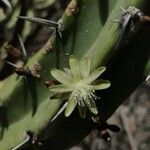Shrub or tree, up to 4-5 m high; trunk short, branches many, up curving, 60-100 mm in diam., blue-green; ribs 5 or 6, smooth, low, rounded; areoles 5-30 mm apart. Central spine 1, 10-70 mm long, dagger-like and sometimes 6 mm wide at base, almost black; radial spines 5-9, 2-10 mm long, red-brown to blackish at first, fading to grey. Flowers diurnal, 20 x 25-35 mm, creamy or greenish white, scales small; hypanthium very short; perianth rotate; pericarpel areoles slightly woolly. Stamens relatively few. Fruit globose, spineless, 10-20 mm in diam., fleshy, dark red or purple, very tasty. Seeds broadly ovoid, 1.6 x 1.3 mm, black-brown, dull, relief low-domed; hilum-micropylar region of large size, basal, impressed.
More
A tree like cactus. It grows 4 m high. It has a central stem branching just above the ground. The shoots have a deep blue bloom. There are 5 or 6 smooth and rounded ribs. The spine spots are large. The spines are few and short. These radiate and are 5 mm long. In the centre of these there is on larger spine 2.5-5 cm long. The flowers are small and white. They are 3.5 cm across. The berries are purple. They are 1.5 cm across. They are edible.


